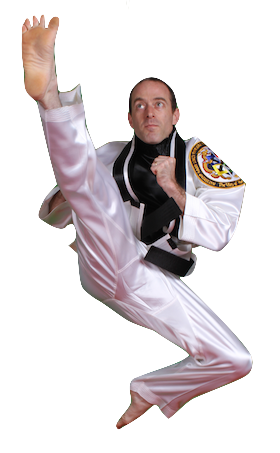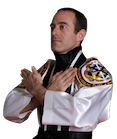
Humility
During a Republican presidential debate in 2007, the candidates were asked for their views on evolution. Senator John McCain said, “I believe in evolution. But I also believe, when I hike the Grand Canyon and see it at sunset, that the hand of God is there also.” Of course, many consider the fact that streams of water could carve out such a magnificent landscape 17 million years ago to be powerful proof of evolution’s central premise: that nature produces profound changes incrementally over a long period of time. But even the more secular among us can embrace the sentiment underlying McCain’s observation: Nature is humbling.
As part of my training to become a Taekwondo master, I recently joined Grand Master Soon Ho Lee and a group of fellow master candidates on a traditional hike up Turtlehead Peak, in the Red Rock Canyon of Nevada. The day became a lesson in humility--and not only because our 69-year-old Grand Master effortlessly negotiated the steep and often rocky terrain, while sixth-degree black belts three decades his junior lagged breathlessly behind. When we all finally were reunited at the peak, we enjoyed a stunning panoramic view of the Nevada desert. The colossal hotels on the Las Vegas strip appeared shrunken in the distance. We gathered and absorbed the scenery, taking pride in how high we had climbed, and how far beneath us the rest of the world now seemed. But Grand Master Lee interrupted the self-congratulatory silence and directed our eyes elsewhere.
“Look up, over there,” he said, gesturing toward an array of mountain peaks behind us. Even after our 2000-foot ascent, the range towered above us. “There is always a taller mountain.”
Our own personal evolution depends a great deal on our continued recognition that there is always a taller mountain. We become better teachers if we remind ourselves that we still have much to learn. We make better decisions if we acknowledge that our instincts are not always faultless. We grow in confidence if we remain aware of our limitations. And we can produce a more lasting legacy if we do not concern ourselves with how we are perceived.
The Humble Leader
When I opened my first Taekwondo club, I relied heavily on the mystique of hidden knowledge. I was 18 years old and a third-degree black belt. I was a successful tournament competitor. I could amaze a crowd at a demonstration by jumping over six people and breaking two boards with a flying side kick. I knew my students were impressed by my skills. When I taught, I parceled out knowledge carefully, always hinting at how much I was not revealing.
I wanted my students to feel that I had an infinite amount to teach them. But creating this impression required me to place myself far above them. I would be the impossible ideal, so they would always feel they had more to learn from me.
The problem with an impossible ideal, of course, is that it is impossible. And so I began to notice that my students were not reaching the heights of skill and confidence that I had enjoyed under my own instructor’s tutelage. They learned the material that I taught, but their performance of it was tentative and uninspired. No natural leaders emerged to motivate the other students. And when I began to train assistant instructors, I was frustrated by their lack of confidence in front of the class.
Eventually, I understood my mistake. I had taught my students that they could never be as good as me. To feed their dependence on me, I had rendered them helpless. I had set myself atop a mountain. But by failing to show them a clear path up it, I convinced them they could never join me there.
My knees no longer permit me to jump over six people. And I cannot perform the fancy acrobatics that characterize the Extreme Martial Arts craze. But I like to think that I am more capable now of producing students who can do those things. I now want and expect my students’ skills to surpass my own.
I approach teaching with greater humility today than I once did. Sure, teaching is in many ways performance. But to the extent that I am the focus, I want my students to be inspired rather than intimidated by my example. I therefore allow them to see not only where I have arrived but how I got here. My curriculum is more transparent, so they know the steps they will take to reach black belt and beyond. If a white belt asks me about a round kick, I do not admonish her for trying to learn an orange belt technique. Instead, I applaud her curiosity and answer her question, while also telling her that she will learn the move in detail after she is proficient at the white belt material.
I also am more willing these days to learn from my students. In the early nineties, I had a student who had competed extensively on the Olympic-style Taekwondo circuit before joining my club. Because I have always felt insecure about my sparring skills, I was apprehensive whenever he came to sparring class. I worried that I would have little to teach him, and that in fact he might be a better fighter than me. During class, I found as many things as I could to criticize about his technique, so that he would respect my superiority and want to learn from me.
Today, my approach is different. One of my students, for example, ran his own kung fu school years ago. Rather than diminish him in order to elevate myself, I have tried to benefit from his expertise. Capitalizing on his experience choreographing demonstrations, I have asked him to help coach my demo team. And recognizing that he is far more knowledgeable and proficient than me with the jahng bong (bo staff), I have relied on him to help others learn how to use the weapon. He recently prepared one of my teenage students for a national weapons competition, and I am proud to say that the student’s performance with the staff was far more impressive than anything I could have accomplished.
It may be obvious to you (as it was not initially to me) that my need to keep the spotlight on my own talents came not from overconfidence but from insecurity. As I have grown in confidence, I have become more willing to step aside and to place my students at center stage. And the best evidence of this increased confidence was my willingness to change my teaching approach when I realized it was not working.
Monitor and Adjust
A student recently came to me with a tearful confession. A year earlier, he said, he had stolen a sweater from a department store. Now, he had a criminal record. He had been afraid to tell me about it, because he feared that his error made him unworthy of my trust or respect.
Perhaps because of my experience as a public defender, I was not shocked by his revelation. I have seen all sorts of people make bad decisions for a range of reasons. So, instead of focusing on what he had done, I asked him to explain why he had done it. My student tried to explain the thought processes that led to the theft, but there was something unsatisfactory about the explanation, because it was clear that he himself didn’t fully understand why he had taken the sweater.
I told him what I often tell my child students: “The test of your character is not whether you make a mistake but whether you learn from it.” Or, to use Confucius’ words, “To err and not reform may indeed be called error.” I also told my student that learning of the theft did not shake my trust in him. This may seem strange, but in my view the humility required to acknowledge a failure is one of the best assurances of future success.
Compare the different approaches of former US Defense Secretary Donald Rumsfeld and his successor, Robert Gates. Rumsfeld was a study in supreme self-assurance. Brash and unapologetic, he seemed never to second-guess himself. But he alienated many in the military establishment, not to mention American allies abroad. And he is widely criticized for failing to anticipate the challenges of the war in Iraq, or to adequately equip our troops to meet those challenges. Eventually, his inability to admit error or to change course led to his forced resignation.
Gates, on the other hand, has taken a decidedly more humble approach. He is no less loyal to President George W. Bush than Rumsfeld was. But he has been more willing to recognize the administration’s failings. Early in his tenure, he conceded that the Abu Ghraib prisoner abuse scandal and the treatment of US prisoners at Guantanamo Bay had harmed America’s reputation abroad. More recently, he acknowledged that the war in Iraq had made it harder for the US to win allied support for anti-terrorism efforts in Afghanistan. This candor has gained him greater credibility than Rumsfeld had, and made him a more effective defense secretary.
Take another example, on the Democratic side. In 1998, President Bill Clinton prolonged the Monica Lewinsky drama and opened himself to impeachment charges by lying about the affair under oath and famously (and falsely) declaring, “I did not have sexual relations with that woman.” Nearly a decade later, San Francisco mayor Gavin Newsom dealt differently with the revelation of his affair with his campaign manager’s wife. Here is what he said, a day after the affair became public:
I am also sorry that I have let the people of San Francisco down. They expect a lot of their mayor, and my personal lapse of judgement aside, I am committed to restoring their trust and confidence....I also want to extend a personal apology to everyone in our administration, to my staff that I just met with, to my friends and my family members. I am deeply sorry and accountable for what has occurred....
Unlike Clinton, Newsom immediately acknowledged the truth of the charges, apologized (he used the word “sorry” four times in his brief statement), accepted accountability, and promised to change his behavior in order to regain the people’s trust. The scandal quickly evaporated, and nine months later Newsom won a landslide re-election.
Acknowledging error is only the first step. As Newsom’s apology demonstrates, it is equally important to correct the mistake. These two steps require awareness and flexibility: Awareness of where we went wrong, and the flexibility to change course. And neither awareness nor flexibility is possible if we lack the humility to question our decisions and modify our plans.
The Songahm Taekwondo instructor training program has a phrase for this process: “monitor and adjust.” When I am preparing trainee instructors to teach, I tell them that they should write a careful lesson plan--and then they should be willing to ignore it. The plan helps guide them and structures their thinking about what they want to accomplish during the class. But during the course of the class, they need to be aware of how well the planned exercises are working. And if the students are becoming confused, or if the energy level of the class is flagging, then the instructor must be flexible enough to deviate from the plan.
One of my students is an aggressive fighter, and she wins matches by forcing herself inside and pummeling her opponent with punches. But she has a hard time against a good kicker, because every time she moves forward she is stopped by a side kick to the ribs or a round kick to the head. When she loses a match, it is usually because she fails to adjust her strategy and continues to forge ahead into these kicks.
This is true, of course, with everything we do. Whether at work or in our personal relationships, the most frustrating impasses typically come when we repeatedly try the same approach to solving a problem. (Einstein is commonly credited with defining insanity as doing the same thing over and over and expecting different results. By this definition, most of us experience occasional bouts of insanity.) The “Eureka!” moments come when we acknowledge that what we are doing isn’t working, take a step back, and suddenly see a different path to our intended goal.
Confident Humility
At a World Championship tournament not long ago, I was a corner judge for a children’s black belt division. The center judge traditionally begins the competition by introducing himself and the corner judges to the competitors. The introductions typically are brief: “My name is Mr. Smith, and I’ll be your center judge.” But this center judge, a man in his 50s whom I’ll call Mr. Franks, instead launched into an extensive recitation of his resume. “I am a fifth degree black belt,” he began. “I have been State Champ in forms, weapons and sparring. I am a Level 4 certified weapons judge and have certifications in single and double ssahng jeol bahng (nunchucks), single and double bahng mahng ee (escrima sticks)…” and on he went. The assembled 11-year-olds appeared nonplussed.
We’ve all met blowhards like Mr. Franks. And we probably all have the same initial response: “What an arrogant jerk! Who does he think he is?” The answer, I suspect, is that he probably doesn’t think all that much of himself. Why else would he feel the need to impress a group of children whose life experience and martial arts experience were a fraction of his own?
Arrogance frequently masks insecurity. Humility, on the other hand, is the ultimate expression of self-confidence. This, I believe, explains an apparent paradox: the fact that children who take martial arts classes are less likely to get into fights. To the lay person, that result would seem counter-intuitive. Indeed, when I tell people that my nonprofit organization provides martial arts training to at-risk children, I often encounter raised eyebrows. “Is that really a good idea?” people ask. “Teaching potentially violent kids how to be violent more effectively?”
But it turns out that several longitudinal studies show what martial arts instructors already know: Martial arts training reduces children’s aggression and decreases the likelihood of juvenile delinquency. Not surprisingly, the same studies find that children who study martial arts gain self-confidence. These two results, I believe, are connected. Fights typically arise out of the desire to “save face.” Someone challenges a child’s masculinity or virility or honor, and the child decides to prove him wrong by beating him up.
But people with confidence have nothing to prove. The insults don’t hurt because the child knows there is no truth to them. And this confidence enables him to walk away from the insult--which, of course, defuses it, since the bully’s goal in leveling the insult was to generate an angry response.
When I was in junior high school, people often tried to pick fights with me. They knew I was a black belt, but they also knew I was 4’9 tall and weighed about 115 pounds. So they often challenged me to see whether my martial arts technique would count for more than my diminutive physique. But because of the confidence that my training had given me, I felt no need to prove myself to them. I would simply say, “I’m not going to fight you. I don’t care what you think.”
The truly confident child can afford to meet attacks with humility rather than swagger. Instead of puffing out his chest and raising his voice, he can quietly stand down. Humility, far from being evidence of weakness, is a sign of strength.
Wearing a White Uniform
The traditional Taekwondo dobok, or uniform, is white and unadorned. It is not meant to attract any attention. Bold colors traditionally were avoided because they distract the viewer from the martial artist’s technique. The white dobok is intended to ensure that we focus on what we do and not on how we are perceived.
That is the essence of humility. When I stopped worrying about how my students perceived me, I no longer needed to draw attention to myself at their expense. When our leaders are more determined to learn from their mistakes than to appear infallible, they gain our confidence. And when a child is unconcerned with proving himself to his peers, schoolyard insults lose their power to provoke. Growth in each of these areas comes from our ability to humbly and confidently wear a white uniform.


